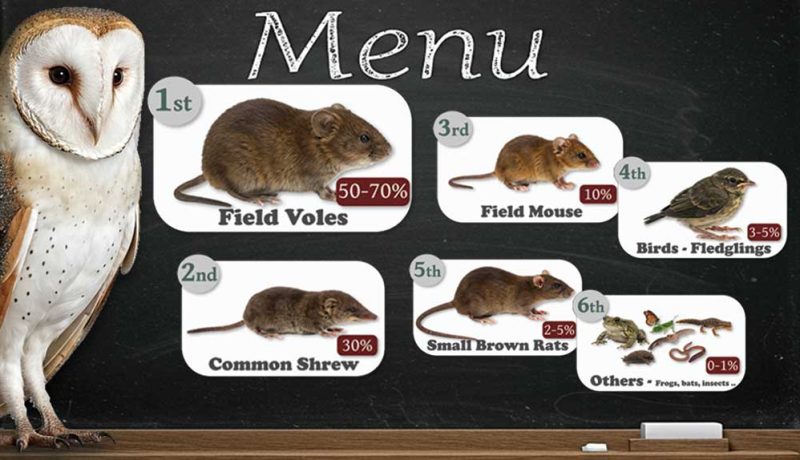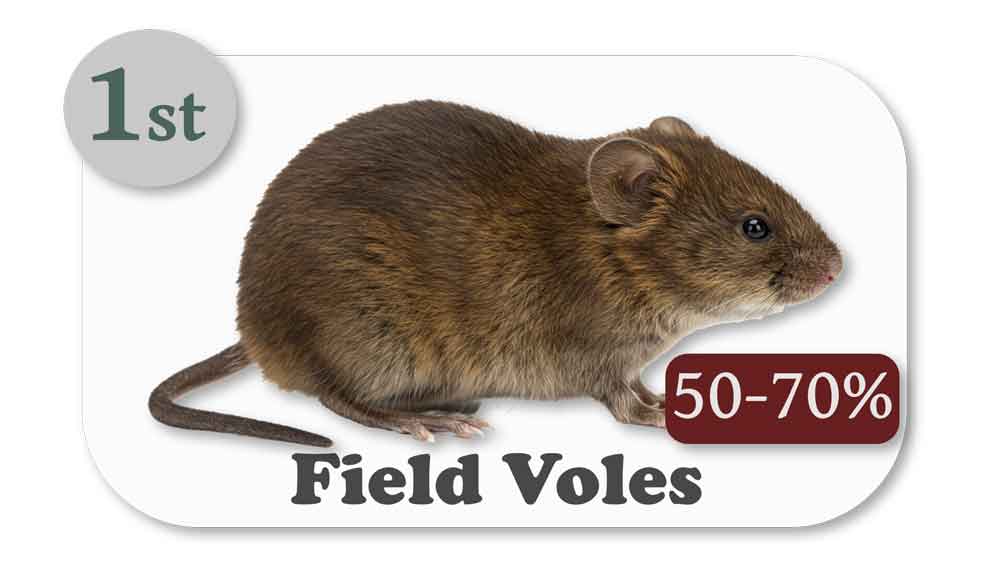

What do Barn Owls eat?
Barn Owls will eat all the following –
- Field Voles 50-70%
- Shrews 30%
- Mice 10%
- Birds – small fledglings (3-5% when raising owlets)
- Small Brown Rats (2-5% when raising owlets)
- Other – Amphibians, bats, insects – Occasionally, during hunger
Barn owls are nocturnal creatures and almost always hunt for food at night. If the weather is poor during the night, you may see a barn owl forced to hunt during the day, but this is more the exception than the rule.
The barn owl’s primary diet consists of quite a few small mammals, including rodents such as voles, shrews, mice and occasionally small brown rats. It uses its sharp talons and powerful beak to capture and consume prey. The barn owl usually consumes its prey whole, swallowing the mice and voles head-first until the tail is finally consumed. The head-first approach is the most efficient way of swallowing a vole whole, and the barn owl has learned and adapted it as a standard eating practice. Head first means the vole’s fur is aligned in the correct direction, allowing it to glide smoothly down its throat.
Similarly, the vole’s legs will naturally fold backwards, making swallowing the vole easier without getting stuck. The barn owl uses a head rocking movement and contractions in its throat to eat its prey quickly and efficiently.
Small mammals are a perfect diet for a barn owl, as the barn owl gets its hydration from what it eats, and these small mammals are proportionally quite “juicy” in terms of blood content compared to an insect. So, the vole is not only a rich source of nutrients for the barn owl, but it’s also how it drinks and hydrates.
Occasionally, barn owls may include small birds in their diet. This is more likely to occur during breeding when they actively seek food for their growing owlets. The chicks of another bird are sometimes used to feed the owlets, which may seem cruel, but it is Mother Nature. While birds, especially nestlings, may be targeted, they constitute a tiny proportion of the barn owl’s overall diet compared to their focus on small mammals.
Small amphibians such as frogs can also form part of the Barn Owl’s diet, but this is quite rare, and it’s more likely to be used as a food source when the owls are feeding their hungry owlets. The growing owlets need many deliveries of food to satisfy their hunger as they grow. The growing owlets can each consume 3-4 small rodents in one evening. With four owlets, a parent may need to find up to 16 prey drops just for the young and 3-4 for itself, which means any prey, including a frog, can be on the agenda.
One intriguing aspect of barn owl dietary habits is the regurgitation of pellets. These pellets contain indigestible parts of their prey, such as bones, fur, and feathers. Analysing these pellets provides valuable insights into the diversity of prey species in a particular habitat, offering researchers a glimpse into the intricacies of the barn owl’s hunting success and diet.
Other ways to accurately identify the diet of a barn owl are to watch them live on a nest camera in breeding season. You can watch and count the different mammals and small birds the male barn owl brings back to feed the female as she raises the young owlets.
On inspection of Barn Owl pellets (that they have regurgitated), remains of insects have been found, indicating that barn owls have also occasionally eaten insects, but this is possibly due to them eating them with other prey such as voles or birds. The insects in the Barn Owls’ pellets are likely to be from the undigested stomachs of the owls’ other prey, such as fledglings.
If you want to encourage barn owls on your own land and watch them hunt for food in the evening as dusk falls, make sure to look after the natural environment and let grasses grow long and don’t mow or cut the grass in fields. Rodents such as voles, shrews and mice love natural long grasses in undisturbed fields, and once you encourage these rodents, the owls will follow.
▪ Download Barn Owl Fact Sheets – Informative & Educational PDF Downloads www.BarnOwl.live/pdf-downloads
▪ Watch Barn Owl & Wildlife Live Streaming Web Cameras @BarnOwlLive on YouTube https://www.youtube.com/@BarnOwllive/playlists/
▪ Comprehensive Online Owl Resources, from the “Barn Owl Live” Website www.BarnOwl.live
▪ Talking Wildlife Podcasts, for enjoyable, easy-to-understand Barn Owl & Wildlife information. https://www.youtube.com/@BarnOwllive/playlists/
▪ For quality Barn Owl & Wildlife Photography search @PeakyWildLife on Instagram or visit https://www.instagram.com/peakywildlife/
▪ Free Barn Owl Screen Savers for Computers & Phones www.BarnOwl.live/pdf-downloads
Please share this article if you like it!
